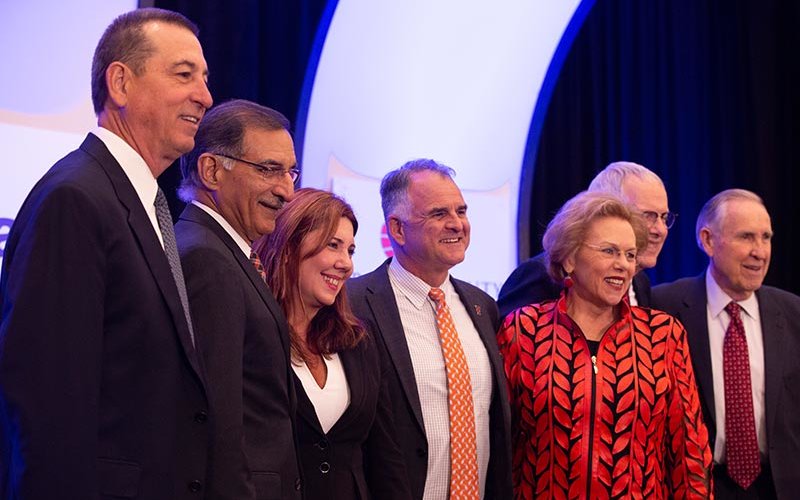
While the U.S. economy will slow down appreciably over the next 12 to 18 months, Cal State Fullerton economists Anil Puri and Mira Farka believe it will manage to escape recession with the expansion remaining intact.
Puri, director of the Woods Center for Economic Analysis and Forecasting, and Farka, co-director of the center and associate professor of economics, presented their assessment of the national and local economy to more than 700 business leaders at the Oct. 30 Economic Forecast Conference, “Deal or No Deal? The Art of Business in an Aging Expansion,” at Hotel Irvine.
Is the Economic Expansion Ending?
“Just because the U.S. economic expansion is 10 years old does not mean it has to end,” Puri began. “What is important is the strength of the recovery, rather than the length of the recovery.” The advantage of having the slow recovery that the U.S. has had, he explained, is that the economy doesn’t have imbalances.
However, concerns about recession remain prevalent. Slowing global and U.S. growth, trade wars, policy uncertainty and lower-than-originally-estimated job growth in the U.S. are all putting downward pressure on business sentiment. And as the U.S. economic expansion ages, it becomes more vulnerable to shocks — much like the aging process in humans.
“There’s no doubt that we’re at a critical junction of the business cycle,” Farka declared. “But there isn’t a single recession culprit out there — there’s just a barrage of negative news, big and small — mostly small. But that’s not how [recessions] work.”
Historically business expansions have come to an end due to one of four reasons: fiscal tightening, oil shocks, overheating with subsequent overtightening by the Federal Reserve, or financial exuberance. The good news is that none of these are imminent threats, said Farka.
A closer examination of financial exuberance — which has caused the last three recessions — shows some potential trouble spots in the economy: skyrocketing corporate debt composed of leveraged loans, high valuations on the stock market, and the loosely-regulated “shadow banking” sector now accounting for 75 percent of leveraged loans. However, this is balanced by the fact that households and bank balance sheets are generally in good shape.
Recession Watch
Puri and Farka created a “recession watch dashboard” to track the performance of several leading indicators, using data from the last seven recessions. Comparing current data to the critical threshold for each indicator shows the risk of recession.
“There are two areas that concern us,” said Farka. “One of them is manufacturing. Manufacturing seems to be in recession territory, but it’s not necessarily spreading to the rest of the economy. And the yield curve is certainly flashing red signals.” Farka noted that the yield curve may be giving distorted signals now that long yields have been suppressed by the many rounds of quantitative easing. She also said that it has given false signals before and clarified that this indicator is more worrisome than alarming at this point.
The duo’s “momentum dashboard,” which tracks trends in areas such as retail sales, housing starts and industrial production, clearly indicates an economic slowdown, but not necessarily a recession. U.S. economic growth slowed to 1.9 percent in the third quarter, from 2.1 percent in the second and 3.1 percent in the first due to weakness in business investments, manufacturing and exports. “Business is pulling back on investment because they are uncertain about the future,” Puri explained.
However, the job market remains good and U.S. consumers — with reduced debt load and disposable wages growing at an average rate of 3.2 percent so far in 2019 — are the main force behind the resilient expansion.
Policy and Political Whims Matter
“This is the first time in a long time that the risk [to the economy] depends largely on policy, and more worryingly, on the political process and political whims,” said Farka.
Trade wars, monetary policy, Brexit, geopolitical and domestic political tensions all have had a huge effect on business sentiment and uncertainty. Monetary policy has limited power to address these risks; the Fed can only soften the blow with lower interest rates.
Puri and Farka expect the Fed to lower interest rates once more in 2019 and once again by mid-2020. Overall, though, the hope is that opportunistic self-preservation among politicians will prevail in making decisions to keep the economy on track.
Orange County Outlook
Puri and Farka expect job growth in Orange County to continue at a moderate pace this year and next, which diverges from the estimate by the state Employment Development Department, the official source of payroll and employment data. Puri explained that for the third year in a row, the EDD appears to be grossly underestimating employment growth for the region.
They project job growth in Orange County to be 1.6 percent in 2019, 0.9 percent in 2020 and 0.8 percent in 2021 and unemployment to reach 3-3.5 percent.
Business sentiment in Orange County is more upbeat than in the U.S. overall. The Orange County Business Expectations survey, conducted by the Woods Center, produces an index where 50 or more indicates expected continued economic growth. The index for 4th quarter 2019 is 90.9. Local business leaders cite political turbulence and trade wars/tariffs as major threats to the economy and more than 60 percent believe the probability of recession by 2020 is 20 percent or less.
The current median price of a home in Orange County is $775,000. Home price appreciation has slowed down substantially, from 4.3 percent in 2018 to only 0.7 percent in the first eight months of 2019. Puri and Farka expect appreciation to remain at 2 percent or less in the near future.
The full economic forecast can be found online on the Woods Center for Economic Analysis and Forecasting website.